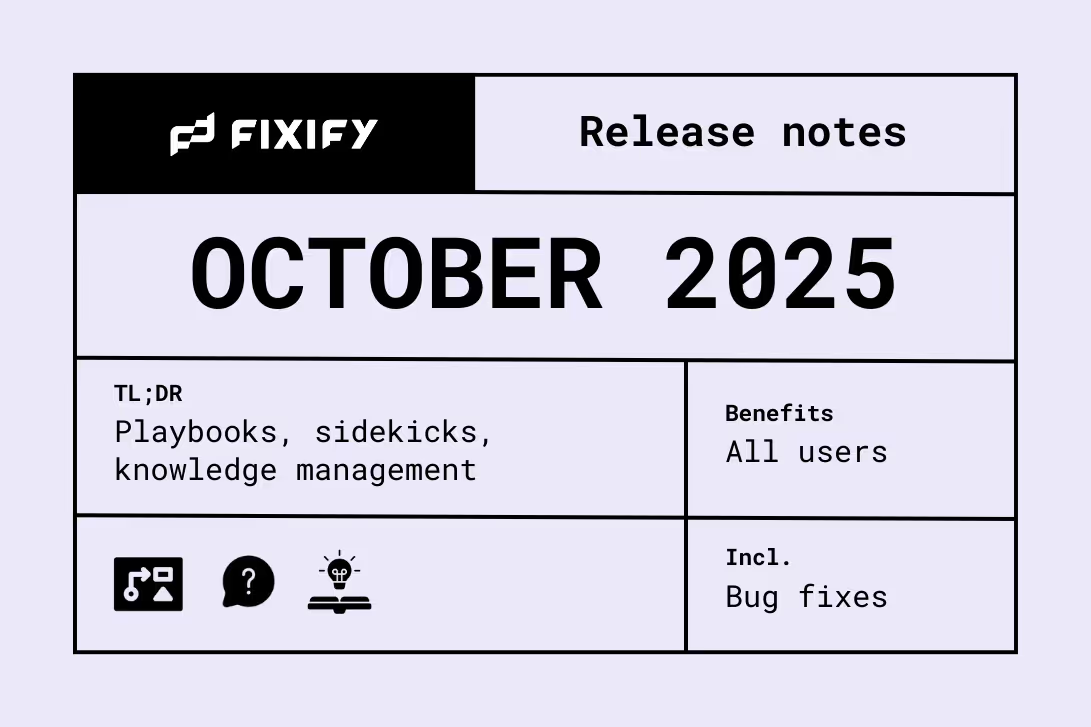IT Support and Services 101: What Every Growing Business Needs

.avif)
Listen to this blog as a podcast

.png)
When your laptop dies before a presentation or a critical tool refuses to load, who saves the day?
That’s the world of IT support and services — keeping the tech side of your business running so your team can stay productive, secure, and stress-free. But there's more to it than just fixing what's broken.
This guide breaks down what IT support and services actually mean, why they matter (especially as you grow), and how modern solutions like Fixify make it easier to keep everything running as you scale up without overwhelming your team.
What IT support and services actually mean
IT support is about resolving issues when they arise. IT services are about keeping things working in the first place. Most companies need both.
If your laptop crashes, the Wi-Fi stops working, or you lose access to a critical system, IT support steps in. If you’re rolling out a new platform, securing your network, or managing a remote onboarding workflow, these tasks fall under IT services.
Together, these functions are the engine that helps businesses stay running smoothly, securely, and ready for growth.
The core types of IT support and services
There’s no single way to structure IT support, but most organizations rely on a few core services:
- Help desk support handles day-to-day issues. It’s your front line support that includes password resets, app glitches, broken devices,, or lost access. Good help desk support fixes things quickly. Great help desk support also improves the employee experience over time. Fixify’s approach to IT support is designed to do both.
- Infrastructure management keeps your backend systems stable. This involves overseeing your servers, networks, cloud platforms, and any hardware or software that form your technical foundation. This is especially critical for growing teams juggling hybrid or distributed environments.
- IT operations management is about the processes behind the tech. It involves monitoring system health, managing configurations, deploying updates, and ensuring compliance with relevant regulations. The right IT operations management tools provide you with visibility and control, enabling you to stay ahead of problems.
- Security services encompass a range of functions, including setting up firewalls and antivirus tools, managing access controls, and responding to security incidents. This is non-negotiable in regulated industries and increasingly required for smaller growing companies and those supporting remote teams.
- Onboarding and offboarding ensure employees get the right access to tools on day one — and lose access the minute they leave. That means provisioning accounts, shipping or reclaiming devices, and coordinating with HR and managers. These workflows are often time-consuming, and where automation can make a major difference.
Common challenges with traditional IT support
For many businesses, IT support is more reactive than proactive. A problem pops up, someone files a ticket, and the team scrambles to fix it.
But as businesses grow, that model breaks down. Tickets pile up. High-volume tasks eat up your analysts’ time. Systems get overlooked. Response times stretch. And no one really knows where the team’s time is going.
Visibility is another big hurdle. Juggling 5+ tools that don’t integrate? That makes it hard to track trends, measure performance, or improve the experience for end users.
Worse, you’re stuck without data — making it tough to justify budget, optimize resources, or advocate for smarter tools. You’re constantly in firefighting mode.
What modern IT support should look like
Modern IT support is less about fixing what’s broken and more about keeping things from breaking in the first place.
That starts with automation. Routine, high-volume tasks, such as password resets or onboarding flows, don’t need to tie up your analysts. Smart routing, pre-configured workflows, and self-service options all reduce friction.
But automation alone isn’t enough. Complex tickets still need a human. Fixify’s approach blends automation with expert analysts who understand your systems.
That’s the human-in-the-loop model: AI handles the repetitive work, real people handle the rest.
Modern tools should also give you real-time visibility. IT leaders need to see metrics like ticket volume, time to resolution, or system health at a glance. With the right system management tools, IT can be a strategic driver, not just a cost center.
Finally, support has to work where your team works. That means integrating with tools like Slack, Jira, or ServiceNow – not clunky portals and email chains.
How Fixify improves IT support and services
Fixify was built to make IT support and services smarter, faster, and less chaotic.
Instead of just handling tickets, Fixify enhances the overall functionality of your help desk. Our model is structured around four steps: understand, eliminate, improve, and automate.
First, we dig into your data to understand where your team’s time is going. We examine ticket volume, types, resolution times, and user sentiment. These aren’t surface-level insights — they’re actionable intel you can use right away.
Next, we reduce noise by filtering out unnecessary alerts and automating repeat requests. Your analysts get their focus back. this includes things like system-generated alerts no one actually needs, or repeat requests that could be handled automatically. It clears the noise, allowing your team to focus on the real work.
Then, we fine-tune and improve workflows. That could mean automatically rerouting tickets to the right person, integrating your communication tools, or updating playbooks so they generate faster resolutions.
Finally, we automate wherever it makes sense. Password resets, app access, and onboarding flows — all streamlined with built-in intelligence and approval logic. You can accomplish more without adding headcount.
Fixify doesn’t ask you to change your entire system. We plug into the tools you already use, work alongside your analysts, and adapt to your team’s processes. And we do it in days, not months.
What IT leaders actually care about
Scaling support without growing the team. Reducing costs without cutting corners. Improving satisfaction without overwhelming staff.
Fixify was built for IT leaders who need to do more without adding headcount. Our customers want to get out of firefighting mode and spend more time planning, optimizing, and leading.
They care about data — real data. Not just ticket counts, but how long each type takes to resolve, what the common blockers are, and how users actually feel about the experience.
They also care about control. They want to know what’s being worked on, how it’s handled, and when to step in. With Fixify, they get full visibility across every touchpoint.
Is Fixify right for your team?
If your team is growing, but your IT headcount isn’t — Fixify could be a good fit for you.
If you’ve tried stitching together tools and it still feels messy or reactive, Fixify can simplify things.
If your analysts are stuck on repetitive tasks and you want them to focus on more strategic initiatives, we can help you shift that balance.
We work best with companies between 100 and 2,000 employees who want a smarter way to run IT without outsourcing everything or hiring a huge team. If you’re curious, this guide for small businesses covers some of the early signs you might be ready.
And if you’re already in the trenches and wondering what’s next, this deep dive from Nerds on Site captures a lot of what we hear from IT leaders every day.
Fixify isn’t a tool you set and forget. It’s a partner in making your IT support smarter, more efficient, and less frustrating—for everyone involved.
Get started by requesting a demo today.
Related articles

October 2025 product release


Is your IT infrastructure showing its age? Here’s how AI + people can help


Managing IT costs: 7 ways to save big without cutting corners

Stay in the loop

Sign up to get notified about our latest news and blogs
.png)